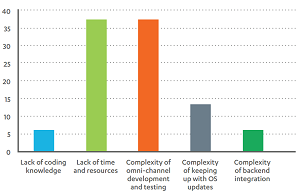News
Survey Reveals Challenges of Wearables Development
- By David Ramel
- September 12, 2016
Wearables provide a new frontier for mobile developers, a new survey says, but they also bring along special development challenges.
Along with the obvious complexity of developing for yet another form factor, the lack of a clear vision from enterprise stakeholders in wearable initiatives and poor communication among vested parties provide even more challenges, indicates a new survey sponsored by Kony Inc. titled The Next Frontier in Cross-platform Mobile Development: Wearables and Connected Devices.
The survey polled 230 developers and designers around the globe to investigate the unique issues associated with creating innovative enterprise mobile apps for platforms beyond smartphones and tablets, such as smartwatches. Kony said responses were collected over a four-week period via a third-party research site. The exact time-frame wasn't provided.
"Forward-thinking enterprises are eager to take advantage of the wealth of new devices and form factors entering the market today, but capitalizing on these innovations remains a challenge for today's mobile app design and development teams," said Kony exec Dave Shirk in a statement today. "To meet this demand, designers and developers need next-generation creative tools that allow them to more easily adapt their apps to a broader range of interfaces, screen sizes and capabilities."
 [Click on image for larger view.]
What Challenges Do You Foresee in Wearable Development? (source: Kony Inc.)
[Click on image for larger view.]
What Challenges Do You Foresee in Wearable Development? (source: Kony Inc.)
Kony provides developer tools such as the Kony Mobility Platform (which last year added analytics functionality) and the MobileFabric back-end service, along with the Kony Visualizer app design and development suite. The company was recently ranked among the leaders in the mobile application development platform (MADP) by research firm Gartner Inc., along with companies such as IBM, Microsoft, Adobe Systems and Salesforce.
In the new survey published today, 65 percent of respondents indicated wearables and connected devices are already a challenge for app developers or will be in the next year. Foremost among the obstacles is "lack of communication between IT stakeholders, designers and developers" (40 percent), followed by "unclear objective from IT stakeholders" (31 percent), "lack of reusability of assets between desktop, mobile and wearable apps" (22 percent) and "other" (7 percent).
On the design side, 69 percent of respondents said wearables already provide challenges or will do within the next year, listing top challenges as "designing mobile apps for multiple devices and platforms" (51 percent), "meeting end-user demand for new applications features" (29 percent), "ease of use of mobile front-end design tools" (about 11 percent) and "changing user interface requests from business units" (about 9 percent).
 [Click on image for larger view.]
What Barriers Do You Face During the Development Stage of Mobile Projects? (source: Kony Inc.)
[Click on image for larger view.]
What Barriers Do You Face During the Development Stage of Mobile Projects? (source: Kony Inc.)
The survey also asked some questions about general mobile development, irrespective of the wearable angle. "Lack of time and resources" tied with "complexity of omni-channel development" (both at 37 percent) as the top two barriers developers face during the development stage of mobile projects. "Complexity of keeping up with OS updates" (about 13 percent), "complexity of back-end integration" (about 6 percent) and "lack of coding knowledge" (about 6 percent) were also listed.
When asked what was stopping developers from rolling out their mobile apps, the No. 1 response was "misalignment between IT and line of business" (39 percent), followed by "lack of time and resources" (31 percent), "no clear vision from stakeholders" (25 percent) and "other" (less than 5 percent).
Forty-two percent of respondents reported they were currently working on two mobile apps, while 36 percent said they're working on more than three, and 21 percent are working on just one app. Over the next six to 12 months, 64 percent of respondents said they would be developing two or more apps.
"As more devices hit the market and wearable and connected devices become commonplace in the workplace, enterprises need a platform to achieve greater agility and efficiencies," the Kony report concluded. "Wearable and connected devices are definitely becoming mainstream, and a key driver for their acceptance will be the growth of enterprise mobile apps built around these devices. It is critical for developers, designers and stakeholders to work closer together to not only to meet business objectives and the demands of the business users, but also deliver an amazing user experience."
About the Author
David Ramel is an editor and writer at Converge 360.